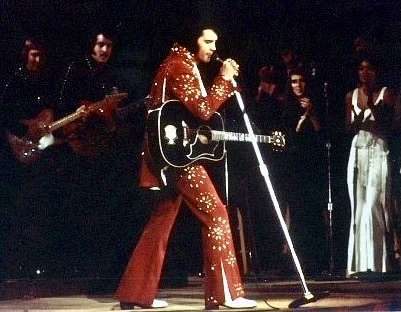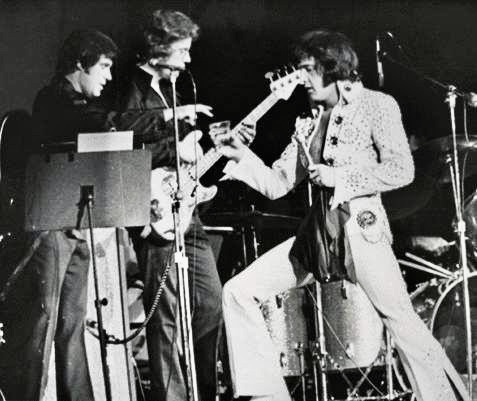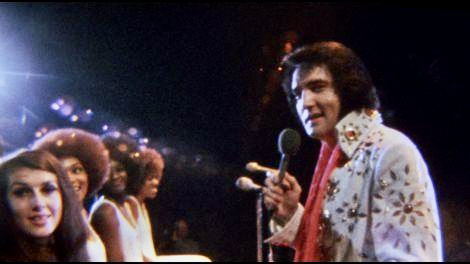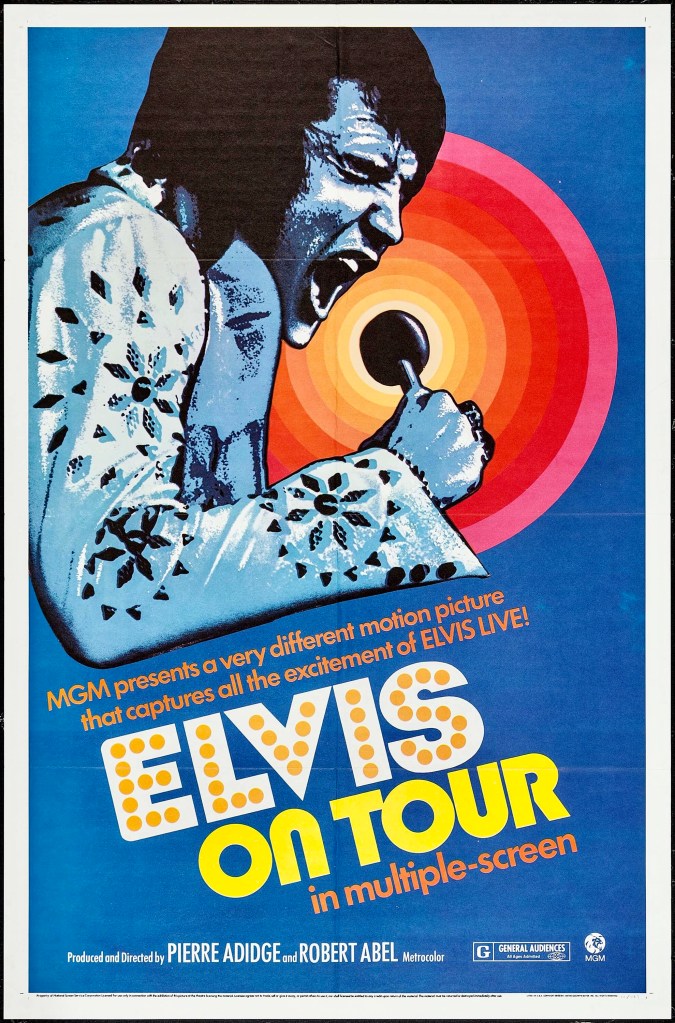
During his lifetime, Elvis Presley made 31 feature films, two theatrical documentaries and numerous TV specials. What is rather surprising is the fact that Hollywood never showcased Elvis as a live performer or in a concert film until the end of his career. How much of that was due to his manager, Colonel Tom Parker, is debatable but Elvis on Tour (1972) is regarded as the last official Elvis movie that was distributed to theaters.
First, a little background. In the early 1970s Elvis was fed up with starring in formulaic musical comedies with interchangeable plots and ingenue leads. He decided it was time for a change and his manager Parker cut a deal with MGM to produce two documentaries that would showcase Elvis in his element – performing live before his adoring fans. There was also an ulterior motive for this. With the singer’s record sales and movie receipts slowly dwindling, it was time to remind audiences that he was still the greatest living entertainer in America, if not the world.
The first documentary, produced in 1970 and directed by Denis Sanders, was Elvis – That’s the Way It Is and it captured the King in rehearsals and on stage during his Las Vegas comeback appearance. The second documentary, Elvis on Tour (1972), focused on Elvis’s cross-country, 15-city tour during April of 1972, which began in Buffalo, New York and ended in Albuquerque, New Mexico.

The filmmakers behind Elvis on Tour were Pierre Adidge and Robert Abel who established themselves with the groundbreaking, split-screen concert film, Joe Cocker: Mad Dogs and Englishmen (1971), a document of Joe Cocker’s 1970 U.S. tour. (Adidge and Abel would also utilize their split screen technique for this documentary and Let the Good Times Roll (1973), a record of promoter Richard Nader’s rock ‘n roll revival show featuring Bo Diddley, Chuck Berry, Little Richard and others).

From the beginning, it was Adidge and Abel’s intention to depict Elvis as a folk hero, one who embodied the essence of American roots music. They were also given complete access to the singer – backstage, in his dressing room, even inside his chartered jets and private limos. “I want to shoot you,” Abel said (in Careless Love: The Unmaking of Elvis Presley by Peter Guralnick), “but the trade-off is, you’ve got to be open with me. If I feel like you’re posing or doing something, I’ll just turn the camera off. And then MGM will just be out of a lot of money.” “I like your honesty,” Elvis said. “When do we start?”

One of the dilemmas facing the filmmakers, however, was how to actually present Elvis to audiences. According to Abel, “I went into the rehearsals in a parochial sense, trying to get to know him, and the gospel part of it was a real insight. But I realized [after a while] with all of the musicians and bodyguards and sycophants around, that these guys had been around for seventeen years now telling the same stories and jokes, and what kind of a life is this? And do I film it? And if I film it, do I show it more than once to make a point?” (from Careless Love).

Certainly, one of the most fascinating aspects of Elvis on Tour are the candid, behind-the-scenes moments: Elvis looking exhausted and lost in his own thoughts after a Florida concert; an awkward, strained encounter between “The King” and a Chamber of Commerce representative from Roanoke, Va. who presents Elvis with a flower-decorated guitar; Vernon, Elvis’s father, looking completely overwhelmed by the pre-concert activity backstage; a funny impromptu moment during Elvis’s performance of “For the Good Times,” when Elvis responds to the lyric “How am I doing?” with the ad-lib “Well, I’m sweating a little bit, baby” instead of “Well, I guess I’m doing fine.”
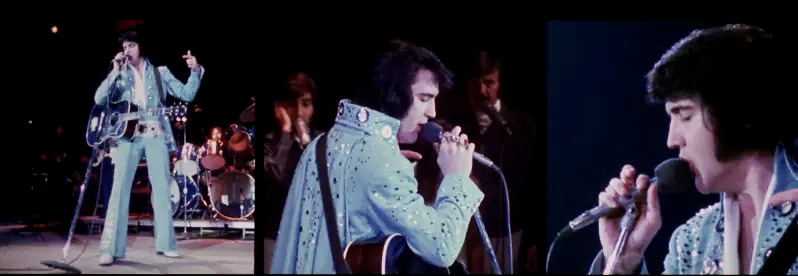
Elvis also agreed to a lengthy interview with the filmmakers that was to be used for those sections of the film that briefly encapsulated the singer’s early career with photographs and film clips such as his appearance on The Ed Sullivan Show. Unfortunately, some of the most revealing material – Elvis reflecting on his Hollywood career (a missed opportunity in his opinion) or past resentments (having to dress in top hat and tails and sing to a dog on the Steve Allen show) – did not make it into the film since it would have undercut the filmmakers’ mythic treatment of him. Nobody was the wiser though and fans were ecstatic at seeing the live concert footage with Elvis repeatedly striking poses with his cape, arms outstretched like some huge winged bird. If he wasn’t jabbing the air with karate chops, he was kneeling down to kiss female fans at the edge of the stage while crooning songs like “Love Me Tender.”
As for the actual filming, biographer Peter Guralnick wrote, “there were eleven cameras in a complicated setup, with sound cued by camera, and all the sound sources fused into a deck from which a temporary scratch track would be created. The cameras operated on a staggered schedule so that, with eleven-minute rolls of film, there would never be a complete shutdown, and with the lightweight state-of-the-art equipment (French Eclair cameras, NASA headsets, Swiss tape recorders to which Abel and Adidge had U.S. rights, and Wally Heider’s mobile recording unit), they were able to move and shoot in a way that Denis Sanders had not even been able to contemplate with That’s the Way It Is.”
The songs featured in Elvis on Tour reflect Elvis’ musical interests at the time as well as the current trends in American pop music. They’re a long way from the path blazing R&B and rock ‘n roll numbers that took Elvis from obscurity to international fame. Whereas he was once seen as an innovator, some fans now saw him as merely an interpreter, performing mainstream pop that was beneath his talent or better left to lesser talents like Three Dog Night. “Never Been to Spain”? “Bridge Over Troubled Water”? “Memories”? Could these compare to the vitality and urgency of “That’s All Right” or “Jailhouse Rock” or “Mystery Train”? Not in the opinion of those fans who preferred the music of Presley’s pre-army period. Nevertheless, the king continued to perform to sell-out crowds around the world who loved his live shows, regardless of his musical selections.
Did Adidge and Abel’s concert film end up revealing a side of Presley never before glimpsed by fans? Not according to some reviewers like Vincent Canby of The New York Times who said this about Elvis on Tour: “It is quite apparent that Mr. Adidge and Mr. Abel are treating him with the kind of respect that French television used to reserve for the formal appearances of De Gaulle. The camera never catches him in a truly candid moment. Close-ups do not reveal anything but, rather, they enshrine an ideal, like an official photograph of a President or a Pope. Compared with “Mad Dogs and Englishmen,” which chronicled the American concert tour of Joe Cocker in a way that reflected Cocker’s tumultuous talent, “Elvis on Tour” seems almost stately.”

Of course, no true Elvis fan would care about Vincent Canby’s assessment – or even bother to read it – and for most of the King’s fanbase, Elvis on Tour was and is essential viewing. His Las Vegas years and larger than life stage shows in the seventies are a key piece of the overall Elvis puzzle. His workaholic commitment to his fans – and the physical toll it took on him – are certainly on display here but so is his love of all kinds of music from gospel (“Bosom of Abraham”) to folk (“An American Trilogy”) to pop novelties (“Polk Salad Annie”).
Not surprisingly, Elvis on Tour performed much better at the box office than his formula musical romances and went on to win a Golden Globe Award for Best Documentary of 1972. It also provided an early career credit for director Martin Scorsese who worked on the film as “montage supervisor.” No one at the time, even Elvis, thought this documentary would be his swan song yet it was the last time Presley participated in a film.
One last bit of trivia: “Burning Love” was first performed live during this tour and became a top ten Billboard hit single
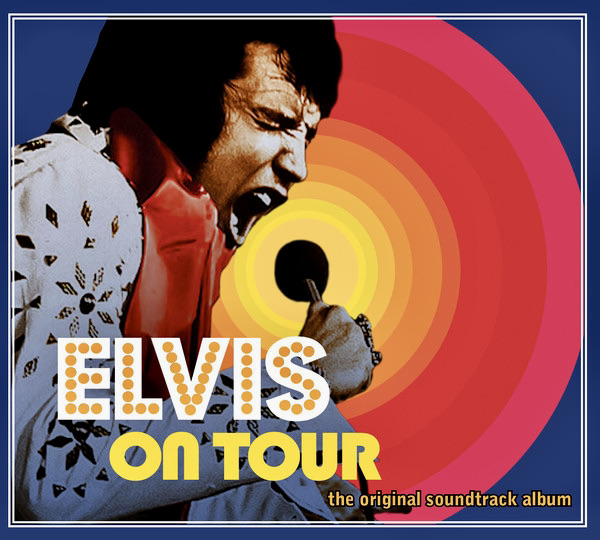
*This is a revised and expanded version of an article that originally appeared on the Turner Classic Movies website.
Other links of interest:
https://movies.elvispresley.com.au/elvis-on-tour.shtml
https://exclaim.ca/music/article/elvis_on_tour-directed_by_pierre_adidge_robert_abel



